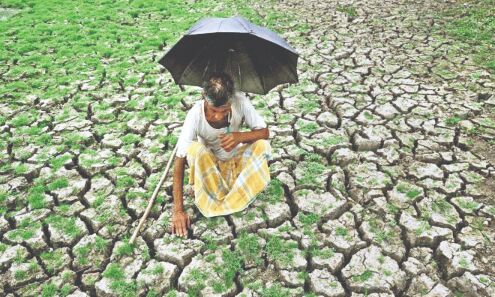Save the land
There is a growing need to regain the fertility of lands impacted by desertification through agro-forestry, soil management and a host of other measures

Cultivated lands in India are in the grip of desertification. The country's Green Revolution pockets are especially prone to the problem. The biggest threat of desertification emanates from the major crops of the Green Revolution — wheat and paddy.
Sardara Singh Johl, a Padma Bhushan-awardee agricultural economist and chancellor of Central University of Punjab, has suggested that if agricultural land in Punjab is to be protected from desertification, the best way is to shift wheat and paddy cultivation to five million hectares of land in the Indo-Gangetic plains of Uttar Pradesh, Bihar and West Bengal
Johl's mantra, unfortunately, doesn't provide concrete measures to pause desertification. The senior agricultural economist should have counteracted the Green Revolution which gave birth to the problem. Transferring a disease from one geographical area to the other is not a remedy because we do not know how to get rid of the causal agent of the disease.
Across the globe
The area most affected by desertification is the dry land which alone constitutes about 40 per cent of Earth's land area and is home to more than two billion people worldwide.
About 12 million square kilometers of the world's arid land is affected by desertification. 10-20 per cent of drylands are already degraded. The rapidly expanding desertification threatens more than a billion people living on drylands around the world.
Desertification is, in a sense, the crawling of death on the land. The desert means a dead land. Death may not be permanent. For example, cultivated land dies almost every year or after every crop season when the nutrient reserves in the soil are used up.
In the long run, despite the huge amount of external inputs applied in agriculture, death on cultivated land will go on creeping, irreversibly and permanently.
India's 'green' death knell
The introduction of the dwarf wheat varieties, developed by Norman Borlaug in Mexico in the 1960s, in Indian agriculture sparked the process of desertification of the earth. The dwarf wheat crops of the Green Revolution licked the fertility of the soil in a few years.
Then, in the 1970s, the International Rice Research Institute in the Philippines dispatched short-duration dwarf rice varieties. The new rice varieties fueled the processes of desertification further.
With very high fertilizer, chemical and water consumption capacity, the dwarf crop varieties of the Green Revolution have two contrasting attributes to offer to humanity: food security and desert.
These agronomic activities have made soil erosion inevitable. Desertification, soil erosion and land degradation are interlinked and affect natural systems as well.
An anthropogenic disaster
All deserts in the Earth's geological history had emerged due to natural factors. But in our contemporary world, the process of desertification is virtually anthropogenic. Desertification associated with agriculture, in fact, is a deep concern that we need to focus on and chalk out workable strategies to prevent the process and reconvert desert lands into fertile fields.
Desertification begins with human activities involving the removal of vegetation from the surface of the land. Deforestation, of course, has become a necessary evil for socio-economic progress in our times.
In the adoption of policies and schemes in areas such as agriculture, road construction, urbanisation, industrialisation, which are important development signs of modern socio-economic development, the desolation of forests seems to have become an imperative.
The essence is that our contemporary world cannot live without devouring the Earth's forests. That is, the desertification of the Earth is at the core of today's civilization
Modern agriculture has no connection to forests. Fertilizers and various types of chemicals and pesticides that destroy soil microbes and other organisms, alter the structure of the soil and destroy its flora and fauna.
Intensive tillage with heavy machinery and equipment, the tendency of growing monocultures, overexploitation of soil, and soil pollution are the processes turning fertile land into unproductive desert. Excessive and frequent irrigation, an essential need of the Green Revolution crops, salinises the soil, causing the death of the soil in the long run.
According to data from the World Food Federation, 3.1 per cent of land in the world is affected by salinisation and 3.4 per cent of land by an excess of sodium.
The Asia-Pacific region is at the forefront of these figures, with 6.3 per cent and eight per cent of land salinisation and sodium excess, respectively. More than nine million hectares of land in India is impacted by salinisation.
Regaining fertility
Soil fertility is a 'byproduct' of the microbial decomposition processes, and microorganisms in the soil thrive on nutrients in organic matter. The food chain of all organisms inside the soil is based on organic matter produced by photosynthesis.
Organic matter flows through the roots, leaves and other parts of the plant into the soil and from there into life via foods. In the soil, such bacteria also thrive, which fix atmospheric nitrogen into the soil, making it available to the plants. But chemical fertilisers and agrochemicals destroy these bacteria further accelerating desertification.
To regain the fertility of the soil, we have to enhance the capabilities of photosynthesis. Although grain crops, like all green plants, do photosynthesis, since they cannot absorb nutrients in the deeper soil layers, the desertification process cannot be stopped.
Unlike these, trees absorb nutrients from the depths of the earth and bring them to the upper surface of the soil, thus protecting the land from becoming a desert. Adoption of agroforestry, raising legumes, recycling of nutrients, nurturing soil with organic fertilizers, expanding the biodiversity base of agriculture, proper management of soil water, and afforestation and reforestation on larger areas of land would prove vital for preventing desertification of the earth.
The writer is a former professor at GB Pant mUniversity of Agriculture mand Technology. Views expressed are personal



